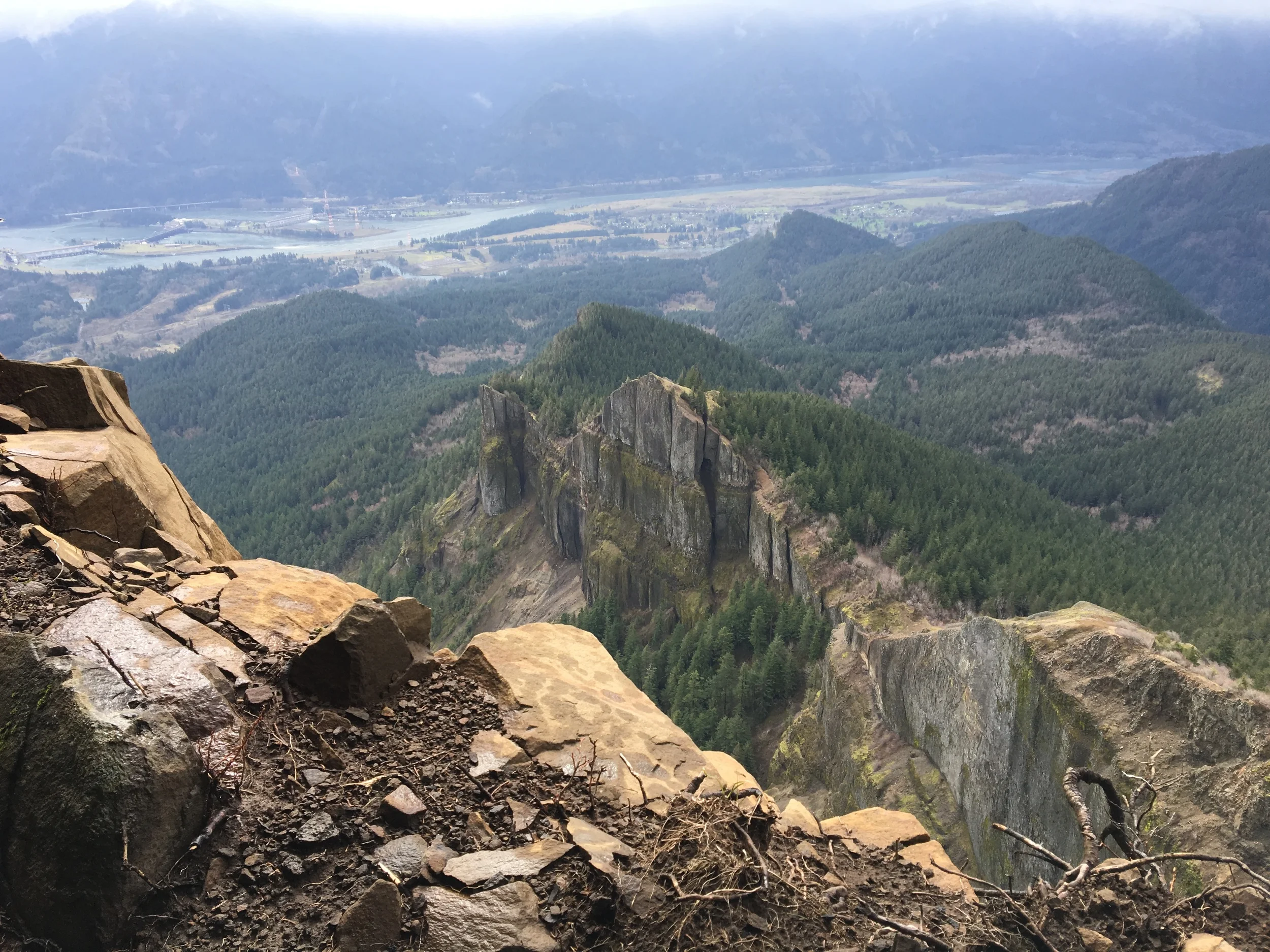By Dan Douthit (@dtonedouthit)
Looming over the western end of the Columbia Gorge is the aptly named Table Mountain, offering a challenging 3,200 vertical feet of elevation gain, varied terrain, and a guaranteed boost towards getting conditioned for even higher peaks. I've hiked Table many times before, usually on bluebird spring or summer days. On a clear day the view at the top is second to none in the Gorge, with the potential for seeing five volcanoes. On March 12, 2016, the conditions were far from ideal, but the experience was no less epic.
Our group rendezvoused at the Bonneville Hot Springs Resort around 8:30am. After paying for a $5 parking pass (redeemable for credit in the lodge after the hike), we hit the trail. The sky was overcast and dry, but the ground remained damp from earlier rain. Less than five minutes in - still within sight of the parking lot - I dunked my boot into a well-camouflaged mud hole. Fortunately my Vasque-brand boot performed like a boss and the mud slurry didn't creep into my socks.
The first few miles were pleasant as the trail snaked through the forest and gradually gained altitude. We passed by several spurs - one leading down a powerline road; the other toward Aldrich Butte. Past the two-mile mark we reached the junction with the Pacific Crest Trail. On this day we didn't encounter any thru-hikers, but we did see the skeleton of a teepee/lean-to-like structure likely used by PCTers.
We took the PCT for about another mile before reaching the true base of Table and the crux of the day's work. From this point, a spur - formerly known as the "Heartbreak Ridge" Loop (not after the Clint Eastwood movie about the Grenada invasion) - rockets up through the forest. Whether out of laziness or a moral aversion to switchbacks, the designers of this stretch decided to retain the natural steepness of the slope in their trail design. The end result is one of the steeper sustained segments I'm aware of in the Gorge.
We kept a steady pace and began our ascent up Heartbreak, pausing several times for a quick breather. The sky remained overcast in all directions, but we began to catch views of the river and the surrounding mountains below the cloud cover. We eventually reached Sacagawea Rock and a flat section of the trail offering stunning views to the east and west.
Then, back in the woods, we pushed onward until we reached a talus field of large stones covering the hillside. The established trail evaporates through this field, forcing hikers to choose their own path between a series of cairns with wooden markers. Stepping slowly to avoid a rolled ankle or smashed knee, we proceeded to the top of the rocks and returned to the forest for the final push to the summit.
With less than a quarter miles to go, we reached another junction and turned toward the top. Upon exiting the woods, we came to the flat "table" part of the mountain. No longer protected by trees, we started to experience strong winds buffeting the summit plateau and surrounding ridges. We quickly traversed across the top of the plateau to reach a sharp drop-off overlooking the Columbia. Upon reaching this point - and just as I was about to eat a fake meat roast beef sandwich washed down by a Fort George IPA - an angry wind howled in from the west. And then a shotgun blast of hail came down followed by blowing snow and diminished visibility.
We made a group decision to eat fast (and refrain from drinking the IPAs), and make tracks down the mountain without delay. Rather than walk across the top of Table and complete the Heartbreak loop, we retraced our steps and went straight down the talus field. The full loop down the west side of Table affords incredible views of the Gorge, but on this day there was nothing to see. We also wanted to avoid additional exposure. The prospect of climbing down a mile of wet rocks above a precipitous drop didn't sound appealing to any of us.
As we descended, the snow began to stick and oscillate in size - from near sleet to large, Charlie Brown-style flakes. Once back in the forest below the rocks, the air temperature warmed to above freezing and we enjoyed a steady rain for most of the rest of the hike. Our journey back to the parking lot was muddier than earlier in the day, but uneventful. In a few places the trail seemed more like a streambed than a hiking path as gravity pulled the afternoon's precipitation toward the Columbia. Upon reaching Bonneville Hot Springs, we used our parking passes for credit in the hotel coffee shop and then headed back to Portland.
Overall - despite the wind, rain, and snow - we won the day. If you wait for a sunny day in March, you may never go hiking anywhere in Cascadia. Equipped with Gore-Tex and gloves, we weathered the inclement conditions with only minimal discomfort. My key lesson learned for future trips is to use more caution when stepping near running water on the trail. My muddy boot dunk 100 yards from the car could have been a major game-changer.
Click here for more photos from the hike.







